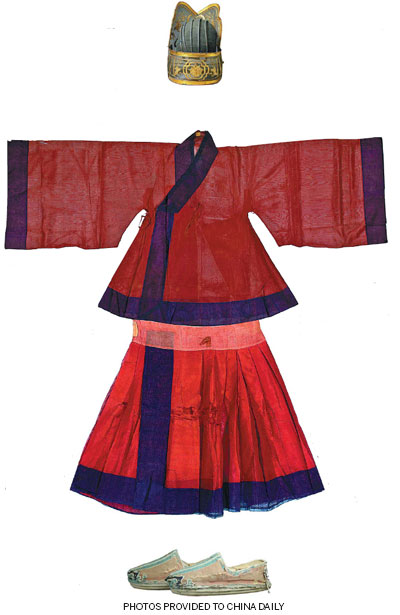
|
Ming Dynasty (1368-1644) clothes belonging to Confucius' aristocratic descendants are amongthe best-preserved of the era and offer hints of lost textile arts. Zhao Ruixue reports in Jinan. Despite being more than 500 years old, the silk garments worn by Yansheng dukes -Confucius' direct descendants, honored as nobility - are as well kept as when the aristocratswore them to meet Ming Dynasty (1368-1644) emperors. The best-preserved Ming clothing was discovered in two black cases in theConfucius Family Mansion in Qufu, Shandong province. There were about100 garments. Of these, some 40 articles of Ming clothing and 50 pieces ofQing Dynasty (1644-1911) clothing were donated to the ShandongProvincial Museum between 1954 and 1956. "Most of the clothing was awarded by emperors. The dukes treasured theselike champions treasure gold medals today," says Song Dong, curator of anongoing exhibition featuring the Ming and Qing nobles' wardrobes in theShandong Provincial Museum. The title Yansheng was created as a marquisate during the Western HanDynasty (206 BC-AD 24). The Song (960-1279) Emperor Renzong(1022-63) raised the 46th-generation descendant of Confucius to the rankof duke. Dukes enjoyed privileges until the Republic of China's founding in1911. Duke Yansheng ranked first or second among civil officials during the MingDynasty. The Records for Qufu shows that Ming emperors awarded Yansheng dukesvarious garments, including court robes, crowns, shoes and jade belts. Thedukes cherished these items. Confucius family members have long highlighted clothing as a crucialcomponent of etiquette. The Confucius Family Mansion employed specialservants to care for the clothing. A servant would take a list of the clothing that the Duke Yansheng coupleshould wear on a special occasion to another servant who was exclusivelyresponsible for getting the clothing from the wardrobe. There were alsoservants responsible for maintaining the clothing. The garments are now kept in a special cabinet with controlled temperature,humidity and illumination ranges. They're displayed on acid-free paper, saysYu Qin, who's responsible for the garments at the museum. "If we can't preserve the clothing carefully, it will carbonize and disappear,"Song says. "After all, silk is mostly protein." Ming Tombs Research Society member Cao Jin points out clothes passeddown for generations are usually in better condition than those unearthed. "It took two years for one person to finish such a robe," Cao says, pointing toa mustard-colored silk robe with an embroidered boa exhibited in themuseum. "The robe is so well preserved that you can even see the stitches." The clothing collection from the Confucius Family Mansion includes perhapsthe world's only complete set of Ming court clothing, Song says. But it's notyet known which duke it belonged to. It consists of a five-beamed crown, redsilk court robe, red silk skirt, white silk inner garment and a pair of bright redshoes with green lining and cloud patterns. The crown is the only one of its kind, although its pin and tassel is missing. Yu Qin, from the museum, says: "Parts of the garments disintegrated when we tried to hangthem up." Song says the most difficult part of restoring Ming clothing is the pigmentation, which was madefrom Ming-era plants. "Nobody knows how to make these today," Song says. |
正在山东博物馆展出的《大羽华裳——明清服饰特展》汇集了国内三家最顶级的明清服装收藏单位——山东博物馆、故宫博物院和曲阜文物管理委员会的二百余件文物,其中服饰147件。展览为期一个月,将在6月18日结束。 “此次展览是世界上首次将明清服制合璧展出。出于对服饰的保护,像这样规模的明清服饰展出在未来的几十年内是很难再现的。”故宫博物院清代宫廷服饰研究专家房宏俊说。 整个展览分为《锦织明韵》和《衣绣清风》两大部分,囊括了出土文物和传世文物。 《锦织明韵》展出出土的鲁王冠冕及孔府旧藏服饰,包括了明代官员朝服、公服、常服、忠静冠服、命妇冠服及一般服饰;《衣绣清风》展出了清代官员礼服、吉服、常服、行服及便服。 明鲁王冠冕 本次展出有一部分重要展品来自于山东省邹城县的鲁王墓。鲁王墓是明代前期的一座亲王墓。1971年从鲁王墓中发掘出各类珍贵文物2000余件。本次服饰展展出了九旒冕及织金盘龙纹黄缎袍等具有代表性的服饰。 “长期以来,对明代前期冠服制度的了解只局限于文字记载,这件九旒冕为我们提供了实物的佐证。”山东省博物馆副馆长王之厚介绍说。 在古代,冠帽是区分身份等级的标志之一。冕是帝王贵族专用的一种帽子。明代冕服的使用仅限于皇帝、太子、亲王、郡王及世子。皇帝用十二旒冕,太子与亲王用九旒冕,郡王及世子用七旒冕。 孔府旧藏服饰 本次展出的明代服饰,除了鲁王墓出土之外,其他均来自衍圣公府旧藏服饰。衍圣公是孔子嫡派后裔的世袭封号,西汉元始元年(公元1年),汉平帝为了尊奉儒学、弘扬礼教,始封孔子后裔为褒侯。此后的千年时间里,封号屡经变化。宋仁宗至和二年(1055年)改封世袭衍圣公。历代衍圣公享受各种特权,一直到中华民国的成立。 据孔府旧藏服饰策划人宋东介绍,根据相关记载,衍圣公府服饰当时是保存在两只皮箱中,大约有100左右件服饰。其中的四十几件明代服饰在1954年至1956年间调拨到山东博物馆保存。 “孔府能够保存这么多完整的明代衣服,很不容易。”宋东说。“即使是定陵这样的皇陵,出土的衣服都已经碳化损坏了,挖出来的颜色信息都已缺失了。” 宋东分析这些服饰之所以会保存的如此完好,其中一个原因是这些衣服大部分是皇帝的赐品。“他们(衍圣公)格外珍惜这些皇帝的赐品。” 而《曲阜县志》有记载:在明代,御赐衍圣公朝服、蟒袍、袍料、冠、靴、玉带、带绶等物。同时记载“衍圣公府家藏元明衣冠,历代视若珍宝,珍藏于内库。 孔子在《大戴礼·劝学》中如是说:“君子不可以不学,见人不可以不饰。不饰无貌,无貌不敬,不敬无礼,无礼不立”。可以看出作为中国封建社会第一大家族,衍圣公府对衣冠的重视。 《孔府内宅生活》中提到孔府中管理衣服的仆人就有很多。衍圣公夫妇如需更换衣服,通常会列好单子交给仆人,另有仆人负责找所需要的衣服。同时,衍圣公府还有专门的人员负责管理衣服,记录衣服的使用情况,并负责晾晒、折叠。 目前,“这些服饰被保存在山东博物馆的专柜里,专柜设有特殊的温度、湿度和照度,并铺有专门保存服饰的无酸纸。”山东省博物馆馆员于芹说。“衣服大都展开平放,防止因压痕断裂。” 然而这些古老的服饰仍然面临消失的困境。 “毕竟这些料子的主要成分是蛋白质嘛。”在大学时学习染织服装专业的宋东说。 宋东说,拯救这些服饰最主要的是制作出植物染料。然而这一技术已经消失,最好能设置研发项目来研究。 “希望能通过这样的展览,让更多的人看到这些服饰,吸引更多的人参与到研究如何保护这些服饰中来。”宋东说。 清帝后服饰 这次展出的明清服饰体系完整,体现了明清服饰制度的基本框架及二者的继承与衍变关系。 清代服饰部分展出了从故宫博物院遴选的六十件清代宫廷系列珍贵服饰以及明代绘画,很多是故宫第一次对外公开展示的珍品级服饰,体系之完整、数量之巨大,是继2008年为迎接奥运会而举办《天朝衣冠——故宫博物院藏清代宫庭服饰精品展》后的首次。 6月8日,故宫博物院著名清代宫廷服饰研究专家房宏俊将在山东博物馆现场讲述这些“清宫帝后服饰”,带您品位“大羽华裳—明清服饰特展”的文化内涵。 “您可以从清朝的服装里看到现今流行的旗袍是如何发展而来的。”房宏俊指着一件清朝女单龙袍给参观者讲解古代服饰对现代服饰的影响。 “每次改朝换代,第一个发生变化的总是服饰。”房宏俊说。 清朝是以满族统治者为主的政权机构,以骑射为主要生活方式的满族人推翻明朝统治后,建立了以满族服装为大流,紧身窄袖的服装,并体现出满汉交融的服饰特点。 然而正是每个朝代对服饰的延续和更新成就了中华服饰文化。如山东文物局局长谢治秀所说:“明代服饰宽大飘逸,清代服饰紧身窄袖,虽然风格迥异,但都给世人留下了深刻的形象记忆。” (中国日报记者赵瑞雪编译) |